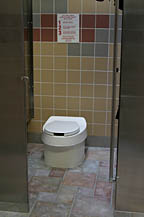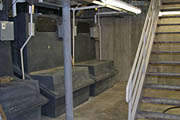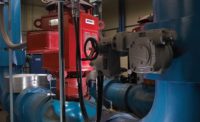

The Plan Takes Shape
The expansion plans called for ADA compliance and the installation of a new leach field and plumbing infrastructure, with flush toilets to replace the old, waterless composting toilets that had been there since 1985. Estimates predicted that the expanded rest area would initially require around 5,760 gallons of water per day to meet the increased demand. Developers were also interested in building a truck stop across the street, and local ranchers wanted a share of the well water, too. In order to meet the increased water demands for these projects, an on-site well was proposed. If all had gone according to plan, the aquifer beneath would have supplied the amount of water necessary to meet the increased demands. No such luck.
A Bump in the Road
First, accessing the well proved more difficult than had been imagined. As it turned out, the aquifer was over a mile deep at the site. But what surprised developers even more, in the summer of 2000, was that when they finally did reach the aquifer, the water that they hit was geothermally heated to an impressive degree. Project manager Tim Belton of Malone Belton Able in Sheridan, WY, said, "When the Department drilled a well to supply the facility with water, it turned out that the well had plenty of water available, but it came out at 165
Problem Solved
Faced with these problems, Belton suggested that the compost toilet system be reconsidered. This idea was not as straightforward as it might have been, since WYDOT had been less than fully satisfied with the original composting systems. The big complaint was odor. But Belton pushed the issue: "I knew that compost toilet systems aren't supposed to smell, and that something was wrong at Mule Creek."
System Basics
When most people think of the composting process, they envision a bin in the backyard with leaves and lawn clippings, not highway rest stops. But as water becomes more scarce, composting toilets are being installed in a variety of locations, including rest areas, ski areas, golf courses, parks and green building projects. Technically, there are few places where compost toilets can't be used instead of conventional waste treatment systems.
The composting toilet system at Mule Creek Junction was designed to fit the rest area's high use projections. It includes six new composters along with five of the original units, which were refurbished by the manufacturer. Toilet waste falls from the toilet fixture through a 14" plastic chute, to the composting tank directly below the toilet fixture. Although the toilet fixture is just a large opening, there is no odor, thanks to a fan that pulls air continuously down the toilet. Urine and feces are separated by gravity in the sloped chamber of the composter, and both are treated by the system. The urine becomes a stable, high nitrogen solution. Although in some instances this liquid is used as fertilizer, at Mule Creek Junction, it is put into a leachfield, along with water generated by sinks. Wood chips are added to the system to help create the proper conditions for composting. After more than a year within the system, the volume of feces is reduced by over 90%. The composted end product biologically and chemically resembles topsoil and can be used as a soil conditioner. It's not expected that it will be necessary to remove the composted end product at Mule Creek for several years.
Composting Toilets Today and In the Future
More than a year has passed since the completion of the expansion at Mule Creek, and the composting toilet system is running strong.So, if composting toilets work so well for Mule Creek Junction, why aren't they used all over? Well, someday they might be. Not only are they used in remote parks and other areas where water is not available; their use is spreading with the popularity of the green building movement. Composting toilet systems are being specified for a widening range of projects, including some in urban areas, such as New York City, Boston, Vancouver, Winnipeg, Grand Rapids and Ann Arbor. And when composting toilets are used along with separate greywater recycling systems, it is possible to eliminate sewage altogether.
Even in projects where doing without a flush toilet is unthinkable, it's still possible to have composting toilets. The foam flush toilet looks and functions much like a conventional toilet fixture. Using a mixture of biocompatible soap and water, the foam flush toilet moves waste through a conventional 4" pipe to the composting tank below. The foam mixture cleans the toilet bowl with every flush but uses only about 3 oz. of water, making it fully compatible with the composting process. And since the foam flush is using water to carry the waste, it is possible to have it offset from the compost system at up to 45 degrees, making the design much like it would be for a conventional toilet system.
Indisputably, today's regulations and the general orientation of engineers favor centralized sewage treatment and septic systems. But as they become more widely understood, composting toilets are likely to become commonplace.

